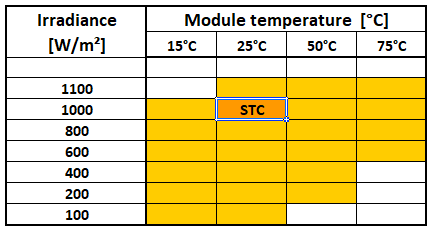Low-light measurements and studies
The determination of the Rserie and Rshunt is based on the behaviour of the PV module in low-light conditions.
As mentioned in the Parameters besides Datasheets topic, testing laboratories use to provide flash-tests measurements according to the IEC 61853 norm. This requires to provide the basic data of one operating point (Isc, Voc, Imp, Vmp) for at 23 different Irradiance and temperature conditions:
Analyzing procedure
In the PV module definitions dialog, PVsyst offers the opportunity of importing such data in a specific tool, for analyzing the measured data from a representative PV module.
The objective is to find a model behaviour matching the measurements at best, mainly concerning the low-light efficiency curve.
This tool is implemented within the dialog of a "normal" module, defined by its commercial data from datasheets (tab "Additional data > Measured Low-light data").
This measured module is constructed independently of the "father" module, as its parameters (namely the STC values [ Isc, Voc, Imp, Vmp ] at 1000 W/m², 25°C) are the measured ones, obviously different than the values of the "father" module.
Especially since in practice, manufacturers usually provide the Laboratory report for one module type (3 identical samples acc. to IEC 61853), for representing all the power classes of a given model.
The tool detemines the parameters (Rserie and Rshunt) suited for matching the low-light measured data, using a one-diode model established from the STC values of the measured module. This optimization may be done either on the full data set, or just for the points measured at 25°C.
For the characterization of modules in the database - when we avail of a detailed measurement report from an independent laboratory - we only use the measurements at 25°C, for several irradiances. So that we can determine the Rserie leading to the best fit with the data points.
Then, the problem is to transfer this information to the "father" module. The Rshunt and Rserie determined here are not transferable, as they closely depend on the STC values. We have to "export" the low-light behaviour, i.e. we search in the Father module the RSerie corresponding to the best corresponding low-light curve.
ISC linearization
In the flash-tests measurements, the different irradiances are obtained by filters. The accuracy of the relative efficiency measurement is directly linked to the accuracy of the filter: an error of 1% on the filter calibration leads to an error of 1% in the relative efficiency.
We may evaluate the Irradiance measurement errors by supposing that the ISC is quite proportional to the irradiance. With this hypothesis we may "recalibrate" the irradiance measurement. We have observed that in some laboratories, the filters at 200 W/m² and 100 W/m² are over-evaluated by 1-2% or more: this strongly biases the low-light performance fit. Therefore this tool provides a way of linearizing the Isc/GRef values of each point.
Global fit
Most laboratories provide the PVsyst one-diode parameters by fitting the five "uncertain" parameters using the 23 measured data points. These five parameters are Rserie, Rshunt, Rshunt(0), RShuntExp, muPmpp.
However fitting 5 parameters on only 23 data points is really reckless. Especially when:
- The equations are so non-linear,
- The measured points are known with rather high uncertainties,
- Some parameters are not really significant, and may take about any value inthe fit.
As an example, the exponential parameter RshuntExp was measured explicitly on many I/V curves directly at sun, for a dozen of modules during months (or years). This was always clearly close to -5.5 for all technologies. With these fits, this parameter may take values of 12 or more (flat behaviour according to irradiance) or very low (straight line between Rshunt and Rshunt (G=0)).
Therefore this fit may be very unstable: intermediate values present hills and valleys, and a little variation of one of the points may lead to a completely different solution.
Moreover the STC values of the "father" module are different, adapting these parameters to another set of data is very problematic.
This is especially the case when adapting these data to modules of different power classes. It seems that some people use to scale the data points and perform the fit again - what is the justification ?.
We also observed that the fitted tmperature behavior muPmpp issued from this global fit may be significantly different from the direct measurement at 1000 W/m2 and 25°C specified on the datasheets, and issued from direct measurements.
